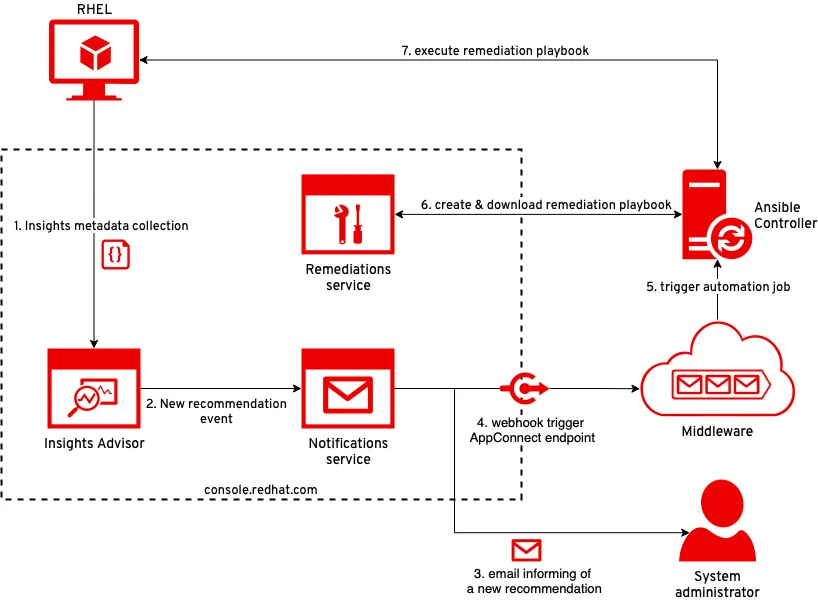This post:
-
Highlights features found in Red Hat Insights and Ansible Automation Platform that can be used as part of a self-healing infrastructure.
-
Walks through an example architecture triggering Advisor events via Insights Notifications service, using a middleware layer for connecting both applications, then launching an automation job template to remediate the detected issue.
Self-healing infrastructure brings together monitoring, streaming, intelligence and automation so that organizations can respond more quickly to datacenter events, reducing operational toil and improving reliability while, to a reasonable degree, minimizing human intervention.
The trigger of events as well as the automation that is applied in response are both part of the story. In this post, we explore how Red Hat Insights and Red Hat Ansible Automation Platform can be used as core components of a self-healing infrastructure.
Introducing Red Hat Insights for analysis
Red Hat Insights is a managed service that continuously analyzes platforms and applications to help enterprises manage hybrid cloud environments. Included with Red Hat subscriptions, Insights uses predictive analytics and deep domain expertise to reduce complex operational tasks from hours to minutes, including helping to identify security and performance risks, tracking licenses, and managing costs.
When an issue is found, Insights Advisor is able to provide remediation steps and, in most cases, a remediation playbook to fix the issue on the targeted system. When this occurs, Insights Notifications can also be set to alert users of the organization via email or forward the details to third-party applications via webhook integration.
Automating with Red Hat Ansible Automation Platform
Red Hat Ansible Automation Platform makes it possible for users across an organization to share, vet, and manage automation content by means of a simple, powerful, and agentless technical implementation. IT managers can provide guidelines on how automation is applied to individual teams.
Meanwhile, automation developers retain the freedom to write tasks that use existing knowledge, without the operational overhead of conforming to complex tools and frameworks. It is a foundation for deploying end-to-end automation solutions, from hybrid cloud to the edge.
Ansible Controller makes it simple to launch playbooks based on defined Job Templates from the Controller’s API. This is the mechanism we invoke as part of our self-healing infrastructure.
Architecting a self-healing infrastructure
With these pieces in place, we can create an event-driven architecture for our self-healing infrastructure. When Red Hat Insights detects an issue, it triggers an event that is forwarded as an action for Ansible Automation Platform to automatically apply remediations.
The message handling, manipulation and forwarding between applications, components, and backend data sources are commonly performed by a middleware layer to speed development and simplify connectivity. There are many types of middleware (e.g., message brokers, enterprise service bus, Integration Platform-as-a-Service, etc.). Examples of such middleware include Red Hat Fuse, IBM AppConnect, Azure Service Bus, or Amazon EventBridge.
Note that this architecture describes an example of a functional integration between Red Hat Insights and Ansible Controller. It is meant to inspire future solutions but does not constitute a Red Hat fully supported reference architecture.
Putting it all together
The following diagram describes the overall architecture and steps for our self-healing infrastructure.

The most important steps are:
-
System metadata is collected by the Insights client and sent over to the Insights platform for analysis.
-
Insights Advisor detects a new issue and offers a tailored recommendation. A “New recommendation” event is generated and forwarded to Insights Notification service.
-
Insights Notifications reacts based on the configuration defined for the organization. In our case, it sends an email to registered users with information about the findings.
-
It also posts a request to a pre-configured middleware endpoint for processing.
-
Once processed, the event details are forwarded to an Ansible Controller’s API to launch a Job Template.
-
The associated Ansible playbook is executed and queries Insights Remediation service’s API to generate a remediation playbook.
-
In turn, it runs the newly generated remediation playbook on the affected system.
-
The last step of the playbook is to execute insights client on the system, which causes Insights to emit a “Resolved recommendation” event and close the loop.
Conclusion
Red Hat Insights and Ansible Automation Platform can be used as core components of a self-healing infrastructure. In our example, we achieved this easily by triggering Advisor events (“New recommendation” and “Resolved recommendation”) via Insights Notifications service. We used a middleware layer for connecting both applications and launched an automation job template on Ansible Controller to remediate the detected issue.
With this solution in place, we can reduce operations handling and improve reliability. The proposed architecture can be adapted to your own operational workflows and processes. Learn more about self-healing infrastructure in our whitepaper, “Accelerate your path to self-healing IT infrastructure.”
Additional information on setting up Red Hat Insights services (e.g., Advisor) can be found in the Insights product documentation, whereas configuration instructions for the Notifications service is available in the Red Hat Hybrid Cloud Console documentation.
An alternative solution using Red Hat Satellite to execute remediation plans from Red Hat Insights is available under the Red Hat Smart Management subscription.
Editor’s note - As of April 1, 2023, Red Hat Smart Management is now called Red Hat Satellite. Product pricing, content and services have not changed. For more information, visit the Red Hat Satellite product page or contact satellite@redhat.com.
저자 소개
Jerome Marc is a Red Hat Sr. Principal Product Manager with over 15 years of international experience in the software industry spanning product management and product marketing, software lifecycle management, enterprise-level application design and delivery, and solution sales.
With more than 10 years of experience in the software industry, Stefan Bunciak is currently the Product Manager for Red Hat Insights. He completed his master's degree in Informatics at Masaryk University in Brno and is skilled in project and people management, quality engineering, and software development. In his spare time, he plays violin in a folklore band.
채널별 검색
오토메이션
기술, 팀, 인프라를 위한 IT 자동화 최신 동향
인공지능
고객이 어디서나 AI 워크로드를 실행할 수 있도록 지원하는 플랫폼 업데이트
오픈 하이브리드 클라우드
하이브리드 클라우드로 더욱 유연한 미래를 구축하는 방법을 알아보세요
보안
환경과 기술 전반에 걸쳐 리스크를 감소하는 방법에 대한 최신 정보
엣지 컴퓨팅
엣지에서의 운영을 단순화하는 플랫폼 업데이트
인프라
세계적으로 인정받은 기업용 Linux 플랫폼에 대한 최신 정보
애플리케이션
복잡한 애플리케이션에 대한 솔루션 더 보기
가상화
온프레미스와 클라우드 환경에서 워크로드를 유연하게 운영하기 위한 엔터프라이즈 가상화의 미래

